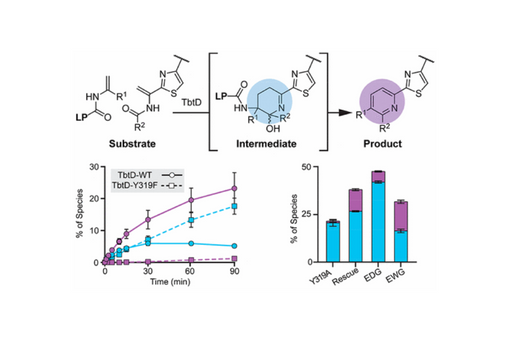Enzymatic Pyridine Aromatization during Thiopeptide Biosynthesis
Abstract
Thiazole-containing pyritides (thiopeptides) are ribosomally synthesized and post-translationally modified peptides (RiPPs) that have attracted interest owing to their potent biological activities and structural complexity. The class-defining feature of a thiopeptide is a six-membered, nitrogenous heterocycle formed by an enzymatic [4 + 2]-cycloaddition. In rare cases, piperidine or dehydropiperidine (DHP) is present; however, the aromatized pyridine is considerably more common. Despite significant effort, the mechanism by which the central pyridine is formed remains poorly understood. Building on our recent observation of the Bycroft–Gowland intermediate (i.e., the direct product of the [4 + 2]-cycloaddition), we interrogated thiopeptide pyridine synthases using a combination of targeted mutagenesis, kinetic assays, substrate analogs, enzyme–substrate cross-linking, and chemical rescue experiments. Collectively, our data delineate roles for several conserved residues in thiopeptide pyridine synthases. A critical tyrosine facilitates the final aromatization step of pyridine formation. This work provides a foundation for further exploration of the [4 + 2]-cycloaddition reaction and future customization of pyridine-containing macrocyclic peptides.
Citation
Enzymatic Pyridine Aromatization during Thiopeptide Biosynthesis
Andrew J. Rice, Jarrett M. Pelton, Nicholas J. Kramer, Daniel S. Catlin, Satish K. Nair, Taras V. Pogorelov, Douglas A. Mitchell, and Albert A. Bowers
Journal of the American Chemical Society 2022 144 (46), 21116-21124
DOI: 10.1021/jacs.2c07377


